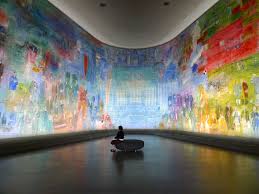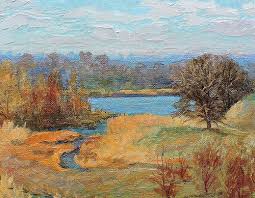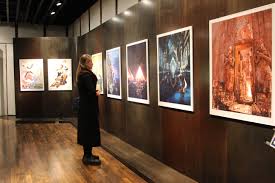HISTORY OF THE ORIGIN AND DEVELOPMENT OF MONUMENTAL PAINTING (part 1)
 FRESCO
FRESCO
It is customary to divide the painting into easel and monumental. To easel painting is one that is made with oil paints on canvas, cardboard or other solid material. As a rule, it has not so impressive dimensions, is performed on an easel and is able to wander around exhibitions, museums, and the interiors of owners. Monumental painting is another matter. It is rigidly attached to the architectural surface, often has gigantic dimensions and the technology of execution has its own characteristics. There are many diverse techniques of monumental painting, but we intend to tell you only about three of them. This is a fresco, mosaic and stained glass.
So…
The term “fresco” means a letter on a raw calcareous base with paints diluted with water, or paints incorporating a lime binder (lime dough, lime water). Calcium oxide hydrate, which is contained in the lime test and, therefore, in the lime solution, is the main element of this technique, which, entering into a chemical reaction with air carbon dioxide, forms calcium carbonate – a transparent glassy structure that penetrates the entire layer of soil and paints and forming a thin transparent film on their surface, fixes (cementes) both the entire soil and the colorful layer of the mural, which it also protects from atmospheric influences. What makes this technique almost timeless. Her death occurs along with the destruction of architecture.
The term “fresco” comes from the Italian expression “a fresko” – in raw, that is, a letter on raw, still fresh calcareous soil. In Italy, where the term “fresko” originated, all murals, in any material that is made in architecture, are called a fresco. In its homeland, the term became firmly established by the end of the fourteenth century, although the method of writing on moist calcareous soil has been used since much earlier times, and has occurred not only on the Apennine Peninsula. As in any other technique, in the monumental painting the work of the masters is difficult. And the fresco requires a particularly thorough preparation of the wall, for the “soil of the painter” will fall only the third in a row. The first two cover the brick or masonry of the wall and level it. And very carefully! So that there are no air bubbles left, so that bumps are smoothed, so that in the second layer, thinner in comparison with the first, the surface would be ideal. It is not for nothing that they “tirelessly” iron it off with a special board. And then, on top of the previous two, smear the stucco layer for painting. Thin, less than a centimeter in thickness, it is imposed in parts and exactly as much as the artist can paint in a day. Otherwise, the plaster dries, and it will have to be scraped off. In the fresco, executed in a “raw way”, connecting seams are often visible, the boundaries between the parts that the artist finished in a certain period. As well as drawings – the contours of a drawing scratched in plaster, translated onto the wall from a previously created cardboard.
Hard case fresco! It requires special skill and courage, and accuracy, and foresight. . . It is necessary to write on raw, until the plaster has dried, while the paint freely flows into the ground. It is necessary to write accurately, because it is difficult to correct, because errors are detected a few days after drying (corrected by tempera). It is necessary to write, anticipating a color change, because in the wet state the colors are much brighter. In a word, the “fresco bud” (it.), The “clean fresco” (good!) Without corrections turns out to be a very rare and elusive phenomenon. That is why the fresco is written not only in a “raw way” (“and fresco” – it.), But also in a “dry way” (“a secco” – it.). They write on dried plaster, mixing lime into paints. It simultaneously serves as whitewash and makes the painting look more like gouache, while water-based paints give the fresco a “watercolor character”.




